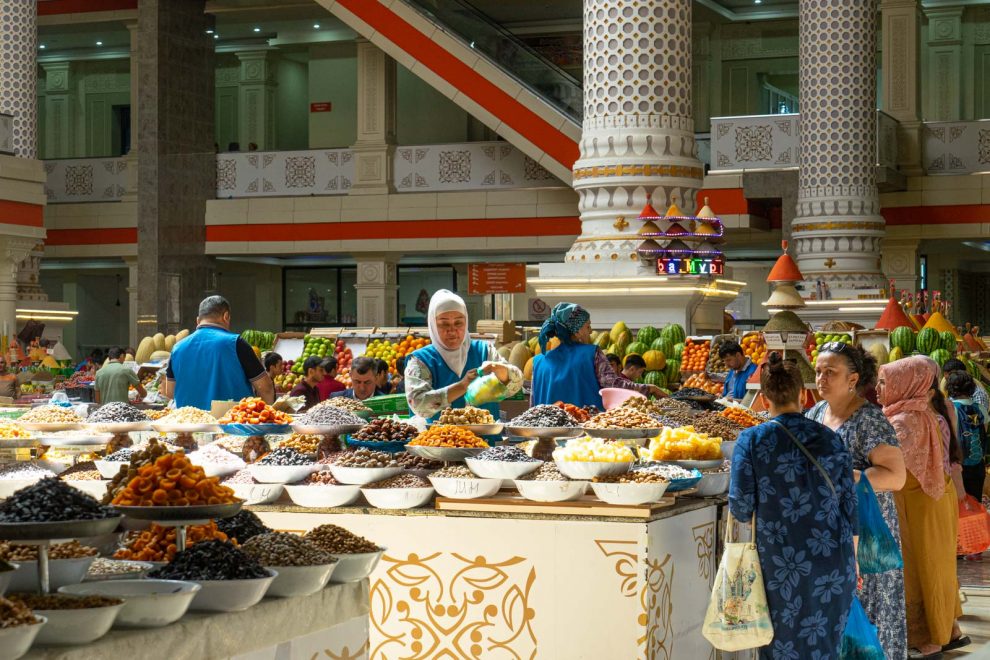This might surprise you to hear. Tajik food is actually quite difficult to find in Tajikistan if you are a traveller new to the country. The food in Tajikistan that you will come accross is probably from its neighbours. Uzbek and Kyrgyz cuisine are extremely popular as well as Persian food.
I doubted whether I should write a post about Tajik food. But then I realized that when I tried to find out about food in Tajikistan before my own trip, there wasn’t much information. A pity, because Tajik food does exist and certainly deserves more attention.
If you don’t believe me I can recommend the wonderful cookbook “With our own hands” based on extensive fieldwork in the Pamirs. It’s probably the only cookbook about food in Tajikistan out there, but the wonderful pictures and unique recipes show a hidden world that few foreigners get to taste.
This post will focus on what to eat in Tajikistan. Therefore I will mention both the truly Tajik food as well as the dishes that are very common in most restaurants in the country.

Tajik food
So what defines Tajik food and why is it so difficult to find? One of the reasons is that Tajik food uses lots of fresh herbs and vegetables and therefore a lot of recipes are seasonal and local.
Every region has its own culinary secrets influenced by what is available in its landscape. One can imagine that this is very different for the cities such as Khujand in the lush Fergana valley compared to the Fann mountains or the high altitude Pamirs.
As most of the country is mountainous things like bread, dairy, fermented milk products, meat and dried fruits are quite important. Dairy and meat is provided by the herders with their sheeps and goats. In the lower altitude areas and the Fergana valley people cultivate the lands to grow wheat, barley or rice. Orchards are also common with fruits like apples, apricots and plums.

Food in Tajikistan
Tajik naan
Bread is obviously not unique to Tajikistan, but it’s so important in Tajik cuisine that it has an almost sacred status. No meal is complete without a piece of bread and there are lots of beliefs about this everyday food. For example, you are not supposed to use a knife and putting it upside down will bring bad luck.
The most common bread in Tajikistan is the Tajik naan. A flatbread made from wheat dough and yoghurt baked in a tandoor oven. It’s very easy to find this in the markets throughout Tajikistan, but it is not the only bread available.
In fact, bread is so central in Tajik cuisine that every occasion has its own type of bread. Some varieties are girdacha (the biggest flatbread made in a tandoor oven), fatir (flaky flatbread cooked in oil) and kulcha (fluffy flatbread).

Qurutob
Qurutob is without doubt the national dish of Tajikistan. It’s name already gives an idea of the essential recipe. Qurut are balls of salty cheese, a popular snack throughout central Asia. Ob means water. So the kurut is dissolved in water, creating a yoghurt-like sauce that is poured over flaky bits of fatir bread. At last, the dish is topped with baked onions and fresh herbs.
It’s a simple, everyday dish, so most versions don’t include meat and therefore it is perfect for vegetarians. However, you might find some that include lamb. Other varieties include fresh vegetables like tomatoes and carrots.
Where to eat: it’s easy to find this dish in Dushanbe where you will find qurutob khona that will only serve qurutob. It makes a great lunch and will cost you not more than a couple of us dollars.
Mastoba
Soups are very popular throughout Tajikistan and are often so rich that they make a filling and satisfying lunch. I had several soups in the country and they were always delicious and full of fresh vegetables and fresh herbs. You can’t really go wrong with ordering soup in Tajikistan. Just keep in mind that they are rarely vegetarian
One of the most common soups in Tajikistan is Mastoba. A dish that is similar to the Uzbek soup Mastava. The basic ingredients are meat, vegetables and rice. However, in Tajikistan the soup is also sometimes seasoned with local herbs and katyk (a fermented milk product).
Where to eat: this soup is quite easy to find in most local restaurants. I had it at Chaikhona rohat in Dushanbe.
Javari
Javari is more difficult to find in Tajikistan, but it was the most delicious soup I had in the country. It is unique to the city of Khujand, because the soup is made from a local pulse (javari) that only grows in this region. Other ingredients include onions, carrots, mung beans and fresh herbs.
Where to eat: Restaurant Zaytun in Khujand.
Penjikent Plov
Qurutob might be Tajikistan’s national dish, but plov is probably the most popular food in the country, if not in all of central Asia. The basic recipe consists of chunks of meat, fried in oil with rice, onions and carrots in a special kazan cauldron. It’s so popular throughout the region that it is difficult to tell where it really comes from. In 2015 both Uzbekistan and Tajikistan claimed plov as part of their national cultural heritage.
Penjikent is famous for having the most delicious plov in the country. Their plov is somewhat unique because they use locally grown yellow carrots instead of the more common orange carrot. However, plov is widely available everywhere in Tajikistan. Prepared well, it is a true feast.
Where to eat: Penjikent bazaar

Kabob
Kabob is the Tajik version of shashlik that is common throughout central Asia. The delicious meat skewers grilled over an open flame are a common sight.
In Tajikistan the meat is often marinated in onions, spices and lemon juice. Because they don’t eat pork, the meat is either mutton or beef. The tail fat is popular as well and pieces of meat often alternate with chunks of the tail fat if they put it on the skewers.

Nahud Sambusa
Sambusa are savoury pastries and they were one of my favourite snacks in Central Asia. The Tajik Sambusa is similar to the Uzbek Samsa. If you have traveled in India the similarities with the samosa are also striking.
In Uzbekistan I mostly had samsa’s filled with meat, sometimes with potatoes. But beyond that, there wasn’t much variety in its fillings. Therefore I was positively surprised to find samsa’s filled with chickpeas in Tajikistan.
Turns out that the nahud sambusa filled with chickpeas is a Tajik speciality. Unfortunately they are not that common, but if you happen to stumble upon them on a market, make sure you try them.
Where to eat: look out for the tandoor ovens at markets and ask if they have nahud sambusa.

Shirchoi
Shirchoi is an acquired taste and I must admit that I wasn’t a huge fan of it. It reminded me of Tibetan yak butter tea and the ingredients are quite similar. Basically it is green tea with milk, butter and salt. It is quite common with breakfast in the Pamirs.
If, like me, you prefer normal tea, it is great to know that Tajikistan is a tea country and tea is part of every meal. Often you get to choose between black tea or green tea. In fact, shirchoi is rarely offered to foreigners, because people know most won’t like it.
Where to eat: ask for it in your homestay when you are on the Pamir highway.
Halvaitar
Halvaitar is a Tajik dessert that comes from the Middle Eastern Halva. Flour, mutton fat and sugar syrup are the key ingredients. Sometimes it is garnished with nuts, if available.
Tajik food from Kyrgyzstan
Tajikistan has a large Kyrgyz minority, especially in the Pamirs. It’s probably the Kyrgyz nomads that introduced fermented milk products and horse meat in Tajik cuisine.
Kurut
These small pocket-sized balls of hard white cheese made from sour milk or yoghurt are central asia’s favourite dairy snacks. Nomads used them for long journeys, but nowadays young and old nibble away when they feel like.
Kurut has an intense salty taste that is hard to digest for those not used to it. I have had many instances in local buses and shared taxis where I was offered kurut and where I had to politely try to eat them without looking too disgusted.

Kazy
Horse meat is a popular delicacy in Tajikistan. However, it doesn’t come cheap and is therefore not eaten every day. In bazaars look out for the horse meat sausage Kazy.

Laghman
Lagman is an Uyghur dish that the Uyghurs brought with them to Kyrgyzstan and Kazakhstan. It’s basic recipe has noodles, meat and vegetables.
Over the years it has become a central asian classic that exists in different varieties. First of all, the noodles can be served with or without a broth and second of all there are different types of noodles. Bozo laghman comes with fried noodles and gyozo laghman with boiled noodles.
Not one laghman is the same and if you order it in a restaurant it can be very hit and miss. I have had terrible laghmans with chewy noodles and bland vegetables. However, I had some delicious ones too, mostly at homestays.

Tajik food from Uzbekistan
The culinary influence from Uzbekistan on Tajikistan is pretty strong. A lot of tajik dishes are varieties of Uzbek classics that got its own twist in Tajikistan. Examples are plov with yellow carrots and the samsa’s with chickpeas.
Uzbek food is very popular and the classic versions of plov and samsa are equally widespread as well as other Uzbek dishes.
Uzbek cuisine itself was hugely influenced by other countries and its position on the silk road. Therefore the true origin of most dishes are as interesting a story as the ones from the traders that introduced them to the region.
Dimlama
Dimlama is one of my favourite foods for lunch or dinner. Probably because unlike most other central asian dishes, meat is not the main ingredient. Dimlama is a vegetable stew with lots of potatoes, carrots and bell peppers and just a little bit of meat.

Manti
Manti are dumplings filled with meat that have become hugely popular in central asia. Some say the dish is from Turkey, but it is more likely that it originated with turkish and mongol tribes that spread this recipe throughout the silk road from China to Turkey.
Each region has its own version. Manti in central Asia are relatively large and steamed in a special metal steamer called a mantovarka. Although the filling is often and preferably lamb meat, there are lots of varieties. In Kyrgyzstan you will also find manti with beef, cabbage, potato or pumpkin.

Source : Backpack Adventures















